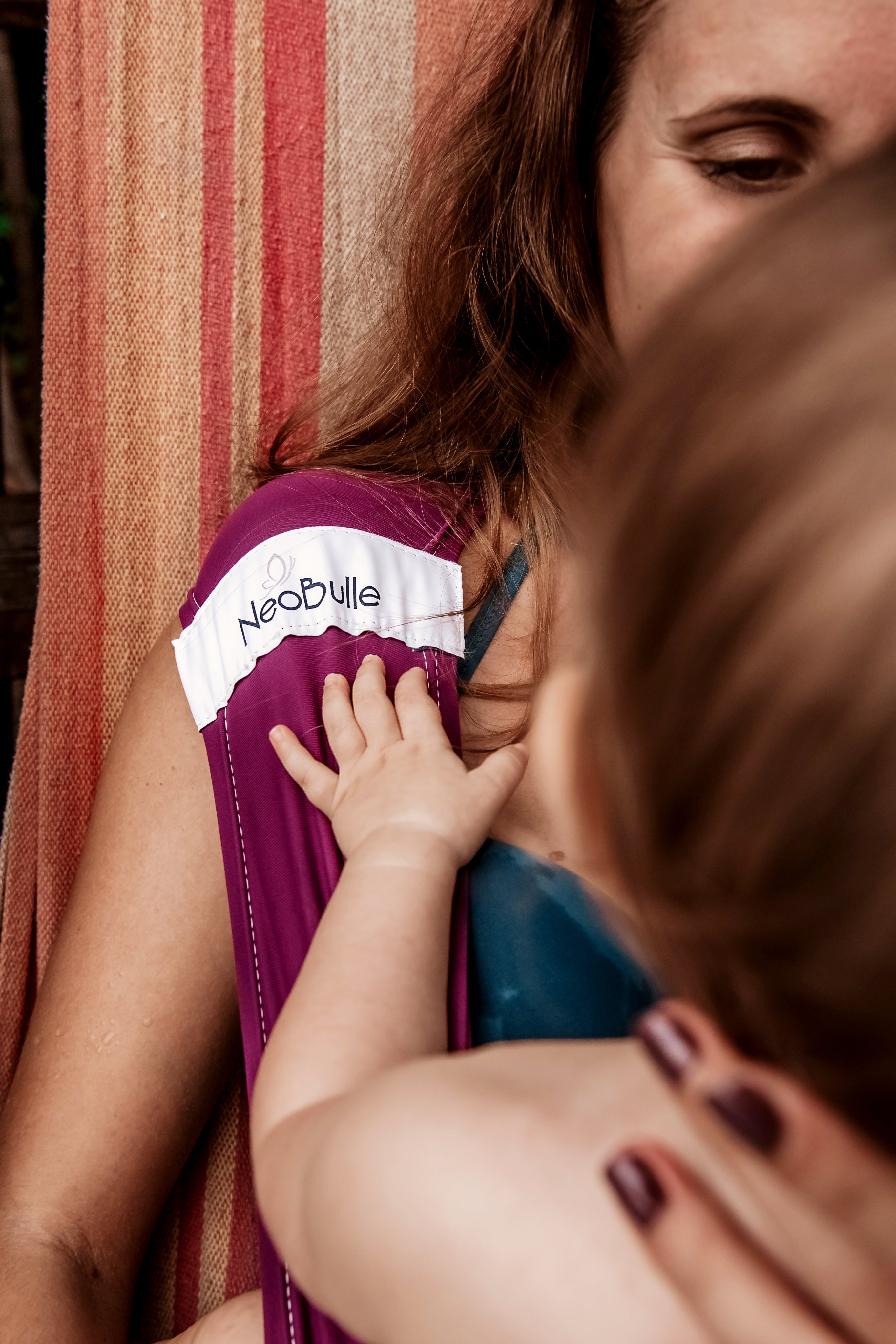Gastroesophageal reflux disease, on a daily basis
All parents who have faced this situation know : between crying, feelings of helplessness, fatigue, and not to mention endless laundry, being a parent of a baby suffering from reflux is hell! And unfortunately, this situation is not rare since it is estimated that this condition affects 1 in 5 babies, or 20% of infants.
Warning signs, tips to relieve, carrying tricks... We discuss this through 2 articles specifically dedicated to this topic!

Physiological regurgitation or Gastro-esophageal Reflux (GER)?
First, a few brief explanations.
Gastro-esophageal reflux (GER for short), is what is more commonly called acid reflux. Ladies, during pregnancy, you probably experienced this, and if so, you usually remember. Because it hurts (a lot). It corresponds to a reflux of part of the stomach contents into the esophagus, which is not designed at all to support the acidity of the liquid in question. This causes very unpleasant sensations of burning, and can, over time, cause an inflammation of the esophageal mucosa (esophagitis).
It is not uncommon to wonder about the difference between a pathological reflux and physiological regurgitations, especially since it is quite common to hear that a baby who regurgitates is normal, and that a crying baby is also normal. Certainly, this can be true to some extent, but even parents of a first child realize when their baby’s crying is abnormal in intensity.
Physiological regurgitations are related to an immaturity of the small valve at the base of the esophagus. After a bottle or a feed, overflows come out (often at the same time as burping), without the baby seeming at all bothered by having soaked your shirt. In fact, he gives you a big smile!
Physiological regurgitations occur just after feeding, the milk that comes out is not at all curdled – pre-digested. And most importantly, your little one is neither bothered nor in pain by these.
In the case of GER, the refluxes are less related to meals, they occur even when the stomach is "empty", and they are extremely acidic. Among the signs that may indicate this, we can find (not exhaustively):
- A baby who cries excessively, is very restless, nervous…
- He often tolerates poorly lying down and you need to keep him upright as much as possible
- He sometimes regurgitates curdled milk from a distance from feedings
- He seems to chew
Obviously, not all babies will show the same signals, some will only display a few, others almost all of them…
Note that reflux is not necessarily associated with milk regurgitation; this is then called 'internal' reflux.
As soon as you have doubts on this subject, it is strongly recommended to inform the doctor or pediatrician in charge of your baby’s medical follow-up, so that they can establish (or not if that’s not the case) a diagnosis, and if necessary, propose treatments to relieve your little one.

Relieve the pain
The first difficulty generally faced is the pain that your little one encounters. He cries, a lot, really screams that leave you completely powerless to relieve him.
We will address more specifically after feeding, which plays a role in this story, but modifying or improving this is often not enough to really limit the damage.
This is where the doctor comes in. Gastric dressings, anti-acids (proton pump inhibitors), they have many tools at their disposal and can help your family and relieve your baby.
Even if obviously no one likes to give medications to their little one, significant pain heavily tips the balance of benefits versus risks (and let’s be honest, when we have a migraine attack or other pain… we also take an analgesic. It’s the same for our little ones).
Reflux can sometimes impact other health spheres of your baby by inducing notably increased ORL vulnerability, or by causing coughing.
The first reflex, therefore, is to make an appointment to discuss the subject with a healthcare professional, which does not prevent simultaneously exploring other levers of action, especially through diet.

Diet and reflux
While baby’s diet is always subject to debate and reflection, it is even more so when the baby shows some particularities! It is often said that in case of reflux, you should space out meals and thicken the milk, but this is not necessarily a very good idea !
Indeed, the most painful refluxes occur not when there is milk in the stomach, but when it is "empty"! It is important to remember that in this pathological case, refluxes are present even outside of meals, regardless of whether there is milk in the stomach or not. The presence of milk helps to slightly soothe the acidity and makes the reflux less painful.
In the case of thickened milk, it often turns out to be less digestible, which can promote… refluxes. Moreover, if the baby no longer regurgitates, the stomach contents still come back up, just a bit lower, and instead of burning only during the ascent, it also burns during the descent…
Therefore, it is advisable to divide meals into smaller portions given at more frequent intervals (especially since drinking milk relieves pain), to help limit acidity and avoid the "large quantity at once" effect, which is often less digestible.
If the baby is breastfed, it is not a question of pulling to thicken the milk, nor stopping breastfeeding! Breast milk is a true "medicine" in cases of reflux, its healing properties especially help greatly in limiting the occurrences of esophagitis. It is also very digestible. Do not hesitate to offer as often as the baby demands.
If the baby is not breastfed, a few small tips can help promote digestion:
- Absolutely warm the milk. At "room temperature," the preparation is very indigestible and requires the baby to expend a lot of energy to regulate its internal temperature after a meal perceived as cold (18-20 degrees Celsius, which is quite cold compared to the body temperature of 37), energy that is not allocated to digestion.
- Offer the bottle in a physiological manner: the baby semi-sits on the parent’s knees, bottle offered horizontally. There will be air at the top of the head, which is normal and not serious. This way of feeding allows the little one to be active during feeding, to not be overwhelmed by too large a flow, and to more easily pause and feel satiety.
- Do not hesitate to offer "on demand" feeding, with smaller, more frequent amounts (not necessarily every 30 minutes). The hungrier and more irritable the baby, the more chaotic the bottle feeding will be, and the less well they will manage —> reflux.

The truth is that there is no single magic solution when it comes to feeding. It is up to each parent to test and find the balance that seems most suitable. With his baby. There is often a small adjustment in the feeding schedule, where we realize, for example, that the little one is more comfortable if we leave 1 hour 30 minutes between two feedings and that if we give really all the time as he demands, it doesn't really calm him down. It's up to you to see what is most suitable for your family (even if we agree, it's not simple!).
Note that in some cases, reflux can be associated with a allergy to cow's milk proteins (generally non-IgE mediated), and in the presence of other warning signs, it may be worth discussing with your doctor to evaluate the relevance of tests and/or elimination.
If your baby suddenly shows significant difficulties in feeding (implying: he is in too much pain), it is an urgent consultation reason. Do not hesitate to call 15 for advice.
Surviving everyday life...
We agree that, said like that, it's not very encouraging, but parents who have been through this know and will confirm: everyday life with a 'GERD baby' as we sometimes read, is a mode of survival!
Intense crying is extremely tiresome and difficult to live with for families. It is a condition that should lead healthcare professionals supporting the baby to be very vigilant about the parents' health (especially psychological). It is a factor that particularly promotes postpartum depression or shaken baby syndrome.
Once the context is set, what do we do?
We do our best.
And as much as we can.
Relieving pain is a priority. For everything else, if the house is a mess and we eat a little more pasta than usual, well, it's not that serious. It’s the right time to reach out for help around you: grandparents, uncles and aunts, friends… Being able to leave your baby for 1 hour to breathe or sleep, or delegate a bit of cleaning and cooking.
You can also find listening ears and resources at PMI centers or parent-child reception areas (LAEP).
Generally, it is important to understand that if your child cries, it is not your fault. You are not doing anything bad, it is not related to any incompetence of yours. You are doing everything necessary to help your little one (by the way, you are precisely reading this article!). It is indeed a pathology.

So, we've covered what reflux is, along with some resources and key points for daily life. Physiological carrying (babywearing) also proves to be a significant help in everyday life, see the second article dedicated to this topic.





